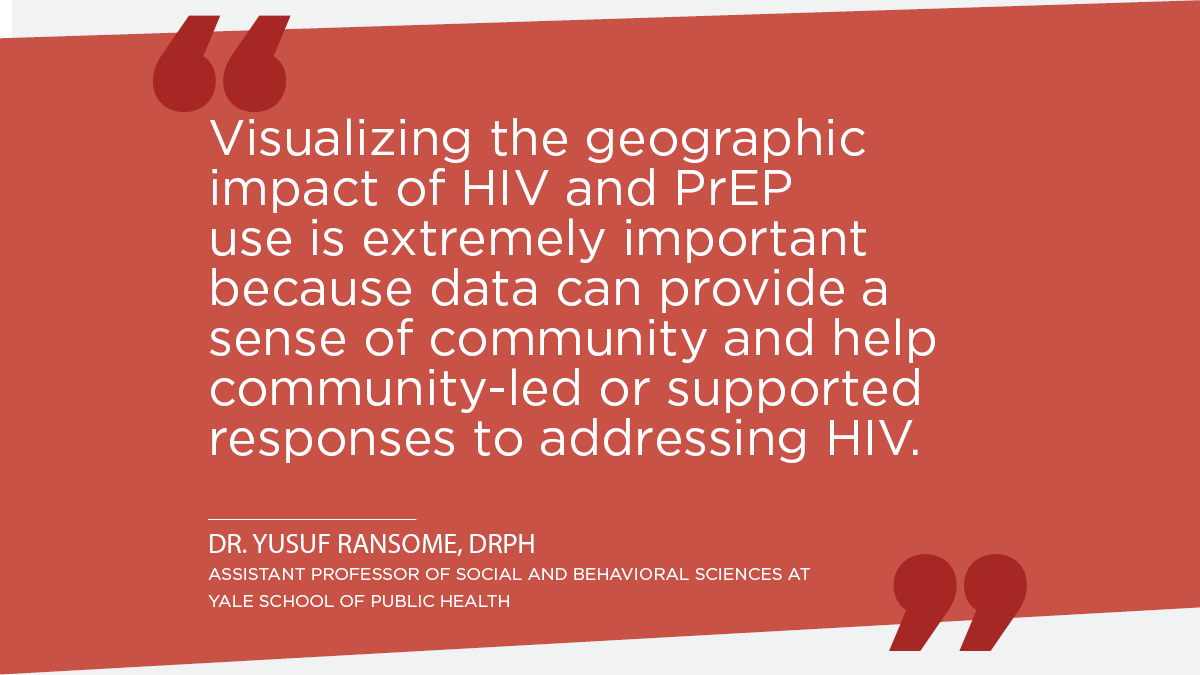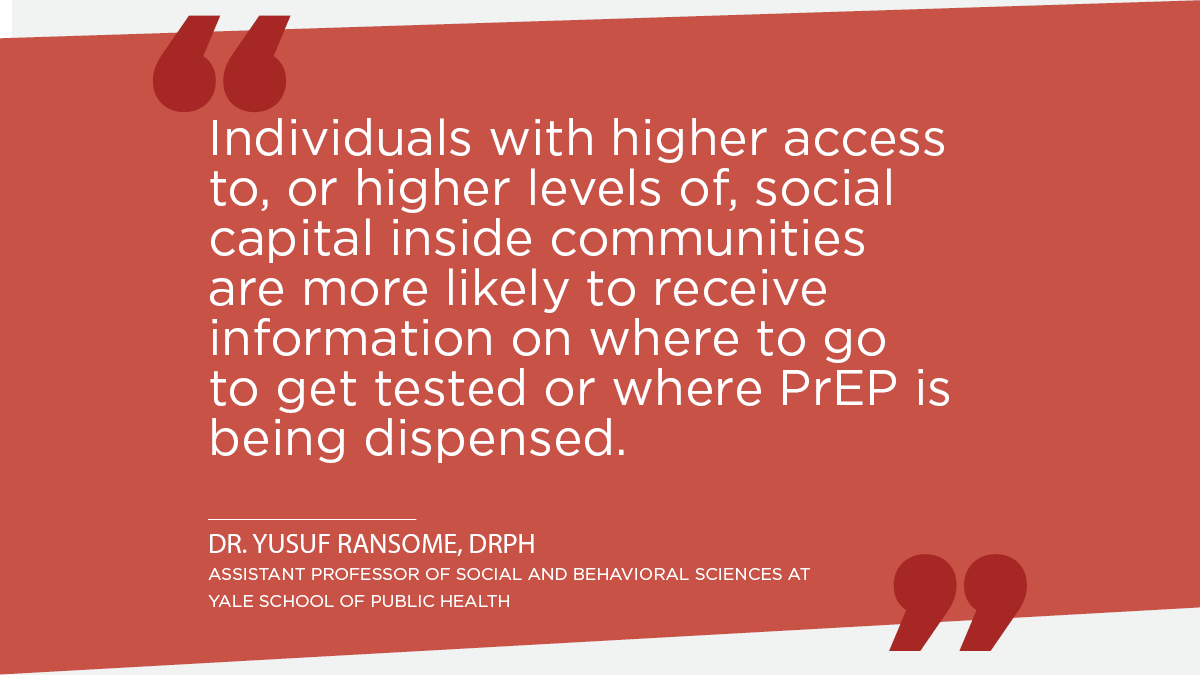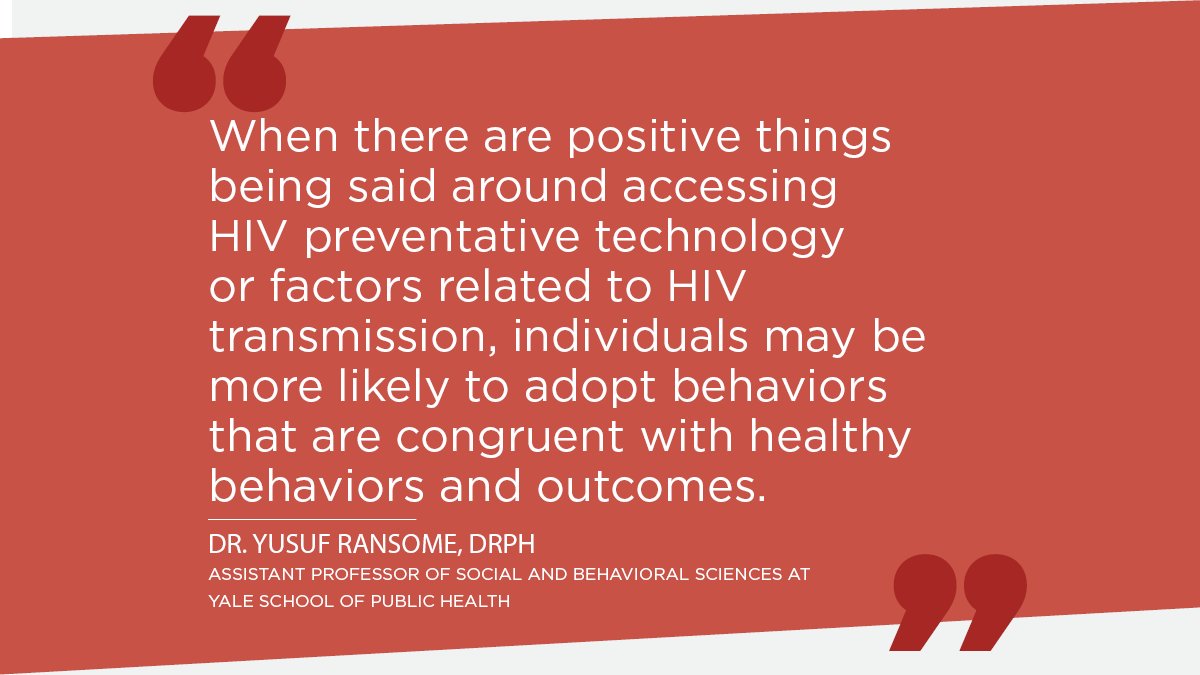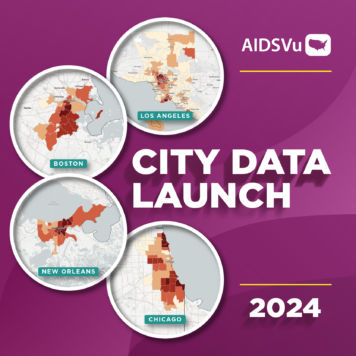Yusuf Ransome, DrPH is an Assistant Professor of Social and Behavioral Sciences at Yale School of Public Health.
Q: You have dedicated your career to studying the relationship between health and social outcomes, specifically focusing on the social determinants of HIV care continuum outcomes. What drives you to do what you do?
My motivation to get into HIV prevention began almost 20 years ago after witnessing firsthand how the social and structural features surrounding HIV stigma, as well as the lack of availability of HIV testing and treatment within the community where I grew up, contributed to both friends and family being diagnosed with HIV in the advanced stages of AIDS. Low levels of social cohesion, collective engagement in health, and other social activities can really thwart people’s ability to access the preventive care they need, and delay early testing and diagnosis.. These same social factors can also inhibit those infected with HIV from accessing the medication the need to live a healthy life. On the other hand, communities characterized by high social cohesion have been shown to facilitate disclosure where individuals can connect with others to draw on social support and other relevant information to access the care they need to live healthy lives.
The same issues I observed that affected my family and friends 20 years ago are affecting the larger population of racial and ethnic minorities, specifically in disadvantaged communities.
The HIV epidemiology today reveals we observe that communities of color, and communities characterized by lower socioeconomic status experience disproportionately higher rates of HIV incidence. Higher incidence rates are in part attributed to community-level factors such as high HIV stigma and inadequate access to specific health care resources. Factors such as HIV stigma and health care access are modifiable. We, therefore, need to further research into how these factors are associated with HIV prevention and care outcomes and the mechanisms that we can intervene on. Interventions will involve multilevel approaches that include structural changes in the environment, as well as changes in social norms and behavior.
Q: You’ve incorporated geospatial analysis and tools like AIDSVu into your research on racial and geographic disparities in HIV care. Why is visualizing geographic impact of HIV so important?
 Visualizing the geographic impact of HIV and PrEP use is extremely important because data can provide a sense of community and help community-led or supported responses to addressing HIV. What we know from decades of research on the impact of neighborhoods on health, is that context matters. We hope that by highlighting that the geospatial context, we can change the conversation in a way that makes it easier for communities to be supportive. By, for example, illustrating the HIV incidence on a specific geographic level, communities can see how the patterns of HIV have changed over time. Changes may be related to specific interventions in those communities, so there is some baseline data. Visualizing geospatial changes (especially if changes were attributed to a community intervention) generates a sense of ownership. Communities can take pride and be empowered to know that they have contributed to supporting individuals who are HIV positive to obtain HIV care. Geospatial analysis can also identify other areas where people still need help and appropriate resources to those areas to improve access to HIV prevention technologies, which are some strategies to decrease HIV incidence within the community.
Visualizing the geographic impact of HIV and PrEP use is extremely important because data can provide a sense of community and help community-led or supported responses to addressing HIV. What we know from decades of research on the impact of neighborhoods on health, is that context matters. We hope that by highlighting that the geospatial context, we can change the conversation in a way that makes it easier for communities to be supportive. By, for example, illustrating the HIV incidence on a specific geographic level, communities can see how the patterns of HIV have changed over time. Changes may be related to specific interventions in those communities, so there is some baseline data. Visualizing geospatial changes (especially if changes were attributed to a community intervention) generates a sense of ownership. Communities can take pride and be empowered to know that they have contributed to supporting individuals who are HIV positive to obtain HIV care. Geospatial analysis can also identify other areas where people still need help and appropriate resources to those areas to improve access to HIV prevention technologies, which are some strategies to decrease HIV incidence within the community.
Q: One sector of your research concerns how social capital and collective efficacy in communities of color can help improve both HIV testing rates and individual PrEP use. How do these factors affect HIV rates?
 Social capital can be defined broadly as resources generated through social connections among individual or group networks that connect people. Based on prior research, from international studies and some in the U.S., we’ve seen several mechanisms that link social capital to a range of HIV-specific outcomes. Some of these mechanisms operate at the individual level, such as late HIV diagnoses, adherence to medication, viral suppression, and more. Information exchange is one mechanism that links the social capital to these HIV outcomes. One primary hypothesis of such work is that individuals with higher access to, or higher levels of, social capital inside communities are more likely to receive information on where to go to get tested or where PrEP is being dispensed.
Social capital can be defined broadly as resources generated through social connections among individual or group networks that connect people. Based on prior research, from international studies and some in the U.S., we’ve seen several mechanisms that link social capital to a range of HIV-specific outcomes. Some of these mechanisms operate at the individual level, such as late HIV diagnoses, adherence to medication, viral suppression, and more. Information exchange is one mechanism that links the social capital to these HIV outcomes. One primary hypothesis of such work is that individuals with higher access to, or higher levels of, social capital inside communities are more likely to receive information on where to go to get tested or where PrEP is being dispensed.
Another mechanism at the individual level is tangible assistance. For instance, one might need a ride to travel to the clinic to get HIV medication. One might need to know someone who can stay home with their children while they go get HIV care. Tangible assistance is one mechanism whereby individuals who have greater access to these resources, might have a higher likelihood of success with achieving high levels of medication adherence and eventually be able to suppress HIV to levels that are undetectable.
A third mechanism at the individual level is emotional and spiritual support. Again, the idea is that some factors like depressive symptoms or anxiety or self-esteem may play a role in someone adhering to their medication. Individuals who generally have a larger and more supportive network are able to draw on that emotional support and receive encouragement that can facilitate timely adherence to medication. High rates of medication adherence is key to suppressing the HIV and maintain a healthy life.
There are also mechanisms that operate at the community level. Communities characterized by high collective engagement can lobby for more resources and have an effect on important things, such as when clinics are open the availability of healthy foods in a community and even the proximity of places where PrEP is prescribed. Another community-level mechanism is social control. There’s evidence from research in Zimbabwe where they used social capital principles as a basis for creating change in the social norms in terms of how community members responded to HIV positive individuals. They used social capital principles to address HIV stigma, which is often a huge impediment in individuals accessing care. Some concrete examples of how social capital was applied are through an intervention that consisted of holding meetings or informal group discussions to educate individuals in these communities. Through education and high levels of interaction among everyone, generated a new social norm. HIV stigma is harmful and should not be accepted in that community. In other words, individuals who are HIV positive have brothers and friends and family members; they are productive citizens, and communities need to see them as human beings in order to reduce stigma. Studies have found that over time stigma declined in these communities when they had informal group discussions with individuals who are HIV positive.
Q: You have also investigated the role of religious and spiritual organizations in encouraging HIV testing and engagement in care. What role can religion play in reducing HIV rates?
 Just like with social capital, religiosity and spirituality, in general, have an impact on two levels. At the individual level research has shown, for instance, that individuals who attend religious services more frequently tend to have better health outcomes. Better health has been shown to extend to HIV-specific outcomes such as including higher rates of HIV testing, higher likelihood to use biomedical technologies such as PrEPetc. From the individual perspective, there are several mechanisms that connect religiosity and spirituality to better HIV-related health outcomes. One mechanism is psychological benefits in terms of being able to access social support within religious institutions. Some religious institutions encourage their parishioners to get timely screenings and use their influence to help their parishioners access medications and prevention strategies. Some recent research I have conducted with my colleague Dr. Bisola Ojikutu suggests that individuals in congregations that heard supportive messages about same-sex relationships a had a higher likelihood of being willing to use PrEP compared to individuals who did not hear or were unsure of hearing such message. The takeaway from that study is that, potentially, when there are positive things being said around accessing HIV preventative technology or factors related to HIV transmission, individuals may be more likely to adopt behaviors that are congruent with healthy behaviors and outcomes.
Just like with social capital, religiosity and spirituality, in general, have an impact on two levels. At the individual level research has shown, for instance, that individuals who attend religious services more frequently tend to have better health outcomes. Better health has been shown to extend to HIV-specific outcomes such as including higher rates of HIV testing, higher likelihood to use biomedical technologies such as PrEPetc. From the individual perspective, there are several mechanisms that connect religiosity and spirituality to better HIV-related health outcomes. One mechanism is psychological benefits in terms of being able to access social support within religious institutions. Some religious institutions encourage their parishioners to get timely screenings and use their influence to help their parishioners access medications and prevention strategies. Some recent research I have conducted with my colleague Dr. Bisola Ojikutu suggests that individuals in congregations that heard supportive messages about same-sex relationships a had a higher likelihood of being willing to use PrEP compared to individuals who did not hear or were unsure of hearing such message. The takeaway from that study is that, potentially, when there are positive things being said around accessing HIV preventative technology or factors related to HIV transmission, individuals may be more likely to adopt behaviors that are congruent with healthy behaviors and outcomes.
At the community level, religious communities often have outreach departments. In that way, they open up their congregation to serve individuals in the larger community. Decades of research have shown that opening the church community can allow people to learn about ministry and religion but also about the importance of health. Those settings may also help with disseminating information about whatever health services the congregation might provide. It also gives other institutions, such as universities, an opportunity to partner with religious institutions to provide support or co-host health-related events. These are only some broad examples of how religiosity can operate at both the individual and community level to address HIV-related disparities and improve health outcomes for all.




